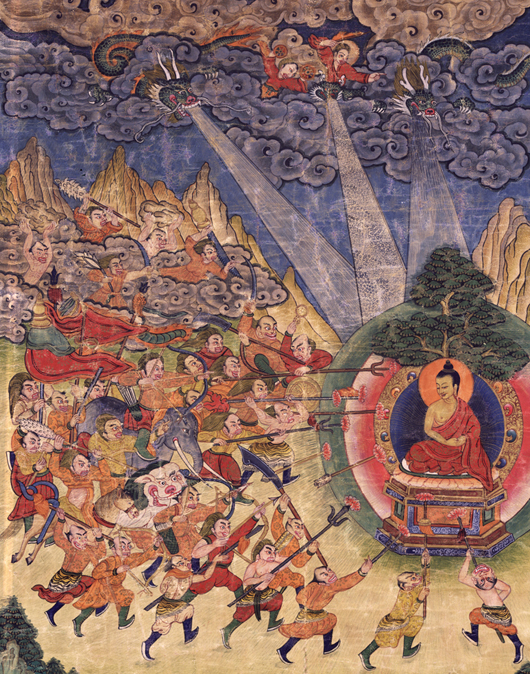
COVER
Victory over Mara (detail); Mongolia?; 19th century; Pigments on cloth; 30 7/8 x 25 1/2
(78.42 x 64.77 cm); Rubin Museum of Art; C2006.66.305 (HAR 699)
The Himalayan region is home to strong narrative traditions-evidence of which is found in a great number of Himalayan works of art. Once Upon Many Times will present the variety of forms that tell stories of the Buddha, great teachers, legendary masters, spiritual quests, and adventures of heroes painted in thangkas, murals, and told in front of portable shrines.
Written by Elena Pakhoutova
INTRODUCTION
A picture is worth a thousand words.
This adage aptly characterizes the topic of this exhibition—the diverse narrative artistic traditions prevalent in Tibetan culture.
For the past millennia Tibetan narrative painting has reflected the rich Buddhist lore of stories, morality tales, and legends initially mostly related to the Buddha's life story, his teachings, and events that span his many lives. These numerous moral biographies originated in India and were embraced in Tibet, where they were adapted to local circumstances, leading to the creation of purely Tibetan narratives.
Tibetan teachers with the help of Indian masters invited to Tibet introduced, translated, and integrated Indian Buddhist culture with a great sense of purpose over the span of several centuries. The artistic expressions of a number of stories presented in this exhibition were modeled after the known Indian visual conventions. Many other stories and their pictorial presentations were developed by the Tibetans themselves and skillfully communicate important aspects of their own culture in order to maintain their religious traditions, inspire spiritual achievements, share myths of the land and its heroes, recount moral tales, or relate their everyday lives to the higher purposes demanded by Buddhist teachings. Each of these objectives invites a certain way of engaging with the images.
This brochure surveys the main themes expressed in Tibetan pictorial narratives: the Buddha's stories, life stories of masters—histories and wonders, stories of spiritual quests and divine protection—and popular dramas.


